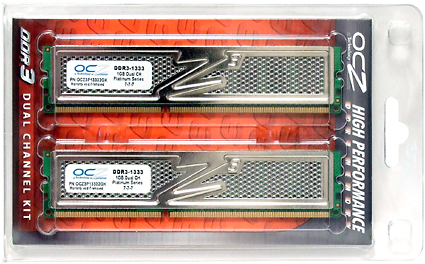DDR3-1333 Speed and Latency Shootout
Conclusion
We wanted to add a value element to our DDR3-1333 comparison Compare Prices on DDR3-1333 Memory and waited months for enough modules to reach the market so that we could get a complete collection of prices. Unfortunately, several of the modules we tested still do not appear on any of our favorite price- search engines, but we can at least consider the prices of those modules we did find. Yet, before we consider pricing, let's take a look at the performances the devices were able to provide.
We've said it before and we have no problem repeating that the best reason to buy DDR3 now is to remove any CPU overclocking limitations imposed by slower RAM. Anyone considering insanely-priced DDR2-1200 or faster modules will find better value in several DDR3-1333 devices.
With overclocking our primary consideration, OCZ's Platinum Edition PC3-10666 wins hands down by beating its own elaborately-cooled ReaperX modules as well as the rest of the field. While many OCZ fans will simply accept this win as par for the course, it's the first time OCZ has actually won any overclocking competition that this author has been involved with. It's great to see the company finally earning a bit of the good reputation it had formerly purchased through clever marketing.
Buyers who are shooting for an overclock to around a 1600 MHz data rate might instead prefer Super Talent's PC3-10600, and buyers looking at stealth might go for the mundane-appearing Kingston ValueRAM.
This was the first time we've included Aeneon modules in a broad comparison, and we're pleased to see the former Infineon memory division alive and well. These might not be winning any awards just yet, but the company might still compete against mid-performance models on price.
Wintec AMPX PC3-10600 took second place in overclocking, and though we've yet to find any available in the market, we know the company plans to undercut OCZ on price. Once again, buyers should weigh any loss in overclocking capability against a potentially lower price.
And now for a brief "Bang for the Buck" segment for the prices we did find: OCZ's PC3-10666 Platinum Edition has a starting price of around $300, which easily beats out the super-high-speed overclocked DDR2 it replaces. On the other hand, Super Talent's PC3-10600 kit clocks almost as high, and it retails for around $250. Edging out Super Talent on the pricing front is G.Skill, but its $240 module set finished at the bottom of both our overclocking and our under-latency tests.
PDP Patriot's 4 GB kit provides twice the capacity of the other modules we tested and, at $580, costs around twice as much. Though it finished around the middle-of-the-pack in overclocking and under-latency testing, high speeds and tight timings are especially difficult to achieve with high-capacity modules. We're sure anyone who would like to use 4 GB or more in their systems will appreciate the fact that these haven't suffered the degraded timings or inflated prices normally associated with high-capacity RAM.
In fact, the only egregious pricing we found was for Kingston's HyperX PC3-1100 kit. Starting at around $480 for only 2 GB of total capacity, buyers could instead choose even faster DDR3-1600 from various brands and still save money. The fact that these "performance" modules were beaten by the brand's own "value" line in both overclocking and under-latency testing bodes poorly for its pricing scheme.
Get Tom's Hardware's best news and in-depth reviews, straight to your inbox.

